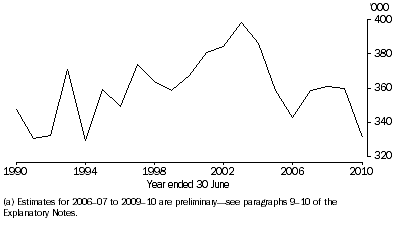INTRODUCTION
Interstate migration is the movement of people from one state or territory of usual residence to another state or territory of usual residence. It is an important component required to calculate Australia's estimated resident population at the state and territory level. State and territory population estimates are used in planning for development and services, and towards the allocation of GST revenue to the states and territories.
There is no direct measure of interstate migration within Australia on a quarterly basis, unlike that of natural increase (births minus deaths) and net overseas migration (NOM arrivals minus NOM departures). Medicare Australia data, which supplies change of address information to the ABS, is the most effective source currently available from a range of potential sources of administrative data (see paragraphs 55 to 58 of the Explanatory Notes). Therefore, estimates of interstate migration are modelled using Medicare change of address data. The model is reviewed and updated every five years using data from the latest Census of Population and Housing. For more information, see Information Paper: Review of Interstate Migration Method, March 2009 (cat. no. 3106.0.55.001).
It is estimated that 331,400 people moved interstate during 2009-10. This is an 8% drop from the same period one year ago (359,900 persons), and a 17% drop from the peak interstate migration estimate (398,600 persons) in 2002-03. This decline has put interstate migration for 2009-10 almost at the same level as the 20 year low in 1993-94 (329,600 persons). With the exception of 2006-07 and 2007-08, interstate migration has followed a general downward trend since 2002-03.
5.1 Interstate Migration, Australia(a)

It is important to note that the total number of persons who moved is likely to be less than the total recorded, after return and repeat movements are taken into account. In addition, for each flow from one state or territory to another, there is a counter flow.
 Print Page
Print Page
 Print All
Print All